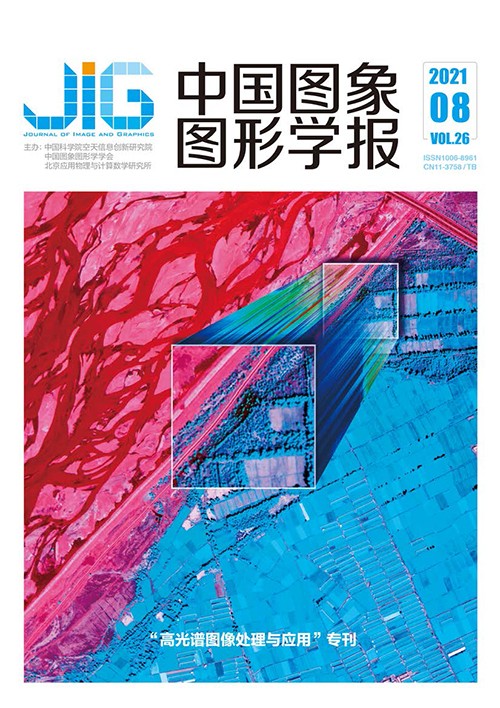
增强类可分性的高光谱图像分类
方帅1,2, 张坤1, 张晶1, 曹洋3, 石为开4(1.合肥工业大学计算机与信息学院, 合肥 230601;2.工业安全与应急技术安徽省重点实验室, 合肥 230601;3.中国科学技术大学信息科学技术学院自动化系, 合肥 230027;4.澳门科技大学计算机技术与应用, 澳门 999078) 摘 要
目的 在高光谱图像分类中,由于成像空间分辨率较低,混合像元大量存在。混合像元使得不同类别的光谱特征发生改变,失去原有的独特性,类内差异变大,类间差异变小。针对这一问题,本文提出基于分组滚动引导滤波的策略。同时针对高光谱图像中存在的“维数灾难”问题,提出了弹性网逻辑回归分类器的框架。方法 通过线性判别分析(linear discriminant analysis,LDA)算法生成具有判别性的引导图,对高光谱图像的每个波段执行滚动引导,从而让光谱曲线呈现类内凝聚、类间距离增大的趋势。通过构造逻辑回归目标函数的L1&L2范数正则项约束进行嵌入式波段选择,为每个类别选择出各自可分性强的波段,同时可以使高度相关性的波段保留下来作为分类依据。最后使用邻域优化策略对分类后结果进一步优化,提升分类精度。结果 分别在3个实验数据集上与其他分类算法进行对比,实验结果表明,本文算法的分类结果取得明显提升。本文算法的总体分类精度(overall accuracy,OA)在Indian Pines、Salinas和KSC (Kennedy Space Center)数据集上分别为96.61%、98.66%和99.04%,比其他算法平均分别高出4.8%、3%和1%,同时也在Indina Pines数据集中进行了对比实验以验证增强混合像元光谱可分性和波段可分性算法的有效性,对比实验结果表明本文算法改善了分类效果。结论 分别在光谱特性和波段选择两个环节增强类可分性,分类精度取得明显提升;同时,本文算法适合不同的数据集,并且在不同数量的训练样本下OA均表现较优,算法具有一定的鲁棒性。
关键词
Hyperspectral image classification with enhanced class separability
Fang Shuai1,2, Zhang Kun1, Zhang Jing1, Cao Yang3, Shi Weikai4(1.School of Computer Science and Information Engineering, Hefei University of Technology, Hefei 230601, China;2.Anhui Province Key Laboratory of Industry Safety and Emergency Technology, Hefei 230601, China;3.Department of Automation, School of Information Science and Technology, University of Science and Technology of China, Hefei 230027, China;4.Computer Technology and Application, Macau University of Science and Technology, Macao 999078, China) Abstract
Objective Hyperspectral images have been investigated and hyperspectral image classification has been widely used in many fields in recent years. Long-distance remote sensing hyperspectral images have a lot of mixed pixels due to the low spatial resolution. The ground features originally have unique spectral characteristics, but the mixed pixels reduce the separability of spectral characteristics of different ground, which increases the difficulty of hyperspectral image classification. Observing the spectral curves of long-distance remote sensing hyperspectral images indicates that the spectral curves of the single type show the tendency of larger difference within the class, and the difference between classes becomes smaller because it is mixed with different types of ground features. If the selected samples are insufficient, then misclassification between classes may occur. Moreover, the classification map has "salt and pepper noise", which leads to low classification accuracy. The traditional method uses the spectral-spatial feature joint classification method to increase the constraint of spatial information for improving the classification accuracy. This way can correct some misclassification results, but it does not improve the problem of difficult classification between classes caused by mixed pixels. Thus, a strategy based on grouped rolling guidance filtering is proposed in this study. The linear discriminant analysis (LDA) algorithm is used to generate a discriminative guidance image, and rolling guidance filtering is performed on each band of the hyperspectral image. Spectral curves show the trend of intra-class condensation given that the guidance image contains the information of classification, and the distance between classes increases. At the same time, hyperspectral images have lots of bands, and many adjacent bands may be heavily redundant and fail to provide additional discriminative information. The generalization capability of the classifier is limited when high-dimensional bands are fed back, that is, the curse of dimensionality, under the condition of insufficient labeled pixels. Reducing the number of bands, that is, dimensionality reduction, is an effective strategy to solve these challenges. The embedded band selection is the best comprehensive performance at present because it solves various matrix-based optimization objectives consisting of different loss functions and regularization terms. However, it exhibits sparsity. If multiple features are useful and highly correlated, then least absolute shrinkage and selection operator(LASSO) tends to keep one and drop the rest. This condition affects the stability. We aim to improve its ability to select groups of correlated variables and utilize its group effect to improve classification accuracy. Thus, we use the framework of elastic net logistic regression to enhance band selection, the respective strongly separable bands are selected for each class, and the strongly correlated bands can be retained at the same time. Method We focus on enhancing spectral separability and band separability of mixed pixels in this study. The framework of grouped rolling guidance filtering and elastic net logistic regression is used to enhance class separability in spectral characteristics and band selection. First, the hyperspectral images are divided into groups according to the spectral direction, and the training data of each group by performing the LDA algorithm are used to obtain the first projection vector. The most discriminative guidance image is generated for each group of hyperspectral images. Then, rolling guidance filtering is conducted on each band of the hyperspectral image. Spectral curves show the increasing trend of intra-class condensation and distance between classes. We use the framework of elastic net logistic regression to enhance band selection. By constructing L1 and L2 norm regularization constraints on logistic regression objective function, embedded band selection is performed to select bands with strong separability for each category, and bands with strong correlation can be retained as the classification basis. We use the neighborhood optimization method to improve the classification results. Result We compare our algorithms with five state-of-the-art classic algorithms on three public datasets, namely, the India Pines, Salinas, and Kennedy Space Center(KSC) datasets. The quantitative evaluation metrics include overall accuracy (OA), kappa coefficient, and average accuracy. We also provide several classification maps of each method for comparison on India Pines dataset. The experiment is repeated 10 times under each experimental condition to improve its reliability and accuracy, and the average value of the 10 experimental results is taken as the final result. Experimental results show that our model outperforms all other methods on India Pines, Salinas, and KSC datasets. Moreover, the OA of the proposed algorithm has achieved 96.61%, 98.66%, and 99.04% on the Indian Pines, Salinas, and KSC datasets, respectively. These values are 1%—4% higher than those of other optimal algorithms. We conduct a series of comparative experiments on Indian Pines to clearly show the effectiveness of different steps of the proposed algorithm. Comparative experiments with a different number of training samples are also performed. The experiment shows that the OA of the proposed method is always the highest under different datasets. By contrast, other comparison algorithms are unstable over different datasets. Therefore, the proposed algorithm can improve the robustness. Conclusion Experiments on three hyperspectral image datasets show that the proposed algorithm enhances class separability in spectral characteristics and band selection compared with other algorithms. The classification accuracy is also significantly improved. The proposed algorithm is suitable for different datasets and has good robustness as well.
Keywords
remote sensing hyperspectral image classification enhanced class separability grouped rolling guidance filtering elastic net logistic regress
|



 中国图象图形学报 │ 京ICP备05080539号-4 │ 本系统由
中国图象图形学报 │ 京ICP备05080539号-4 │ 本系统由